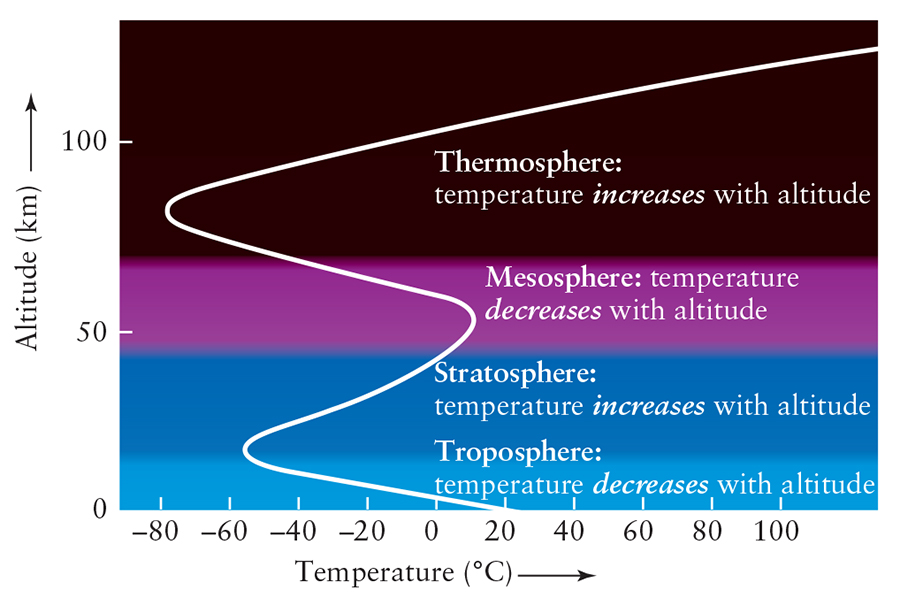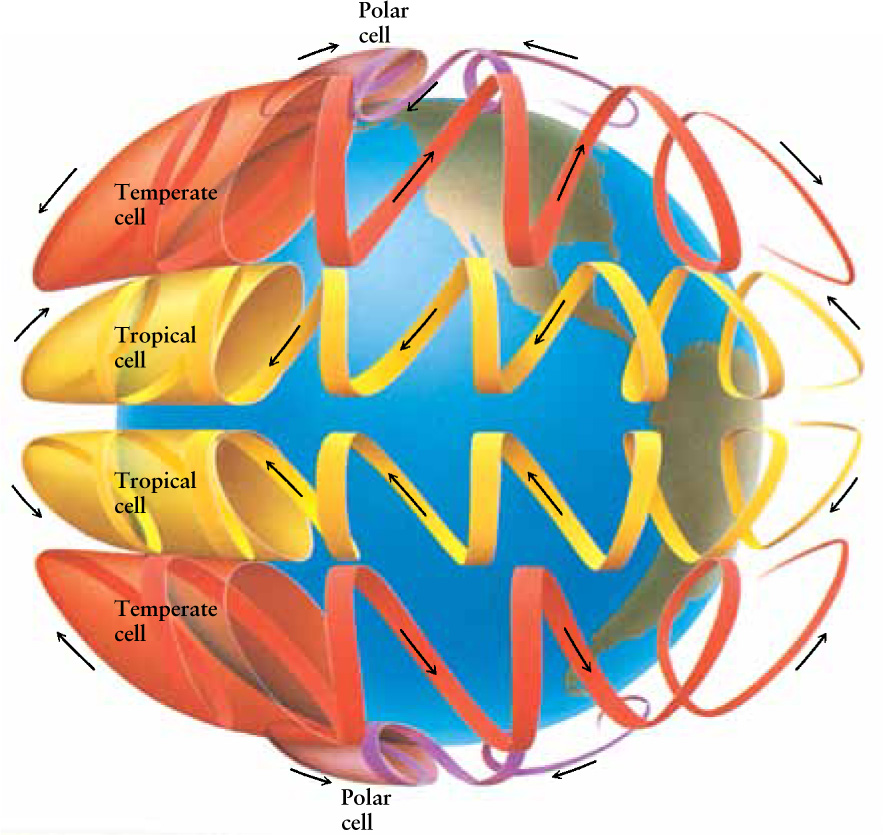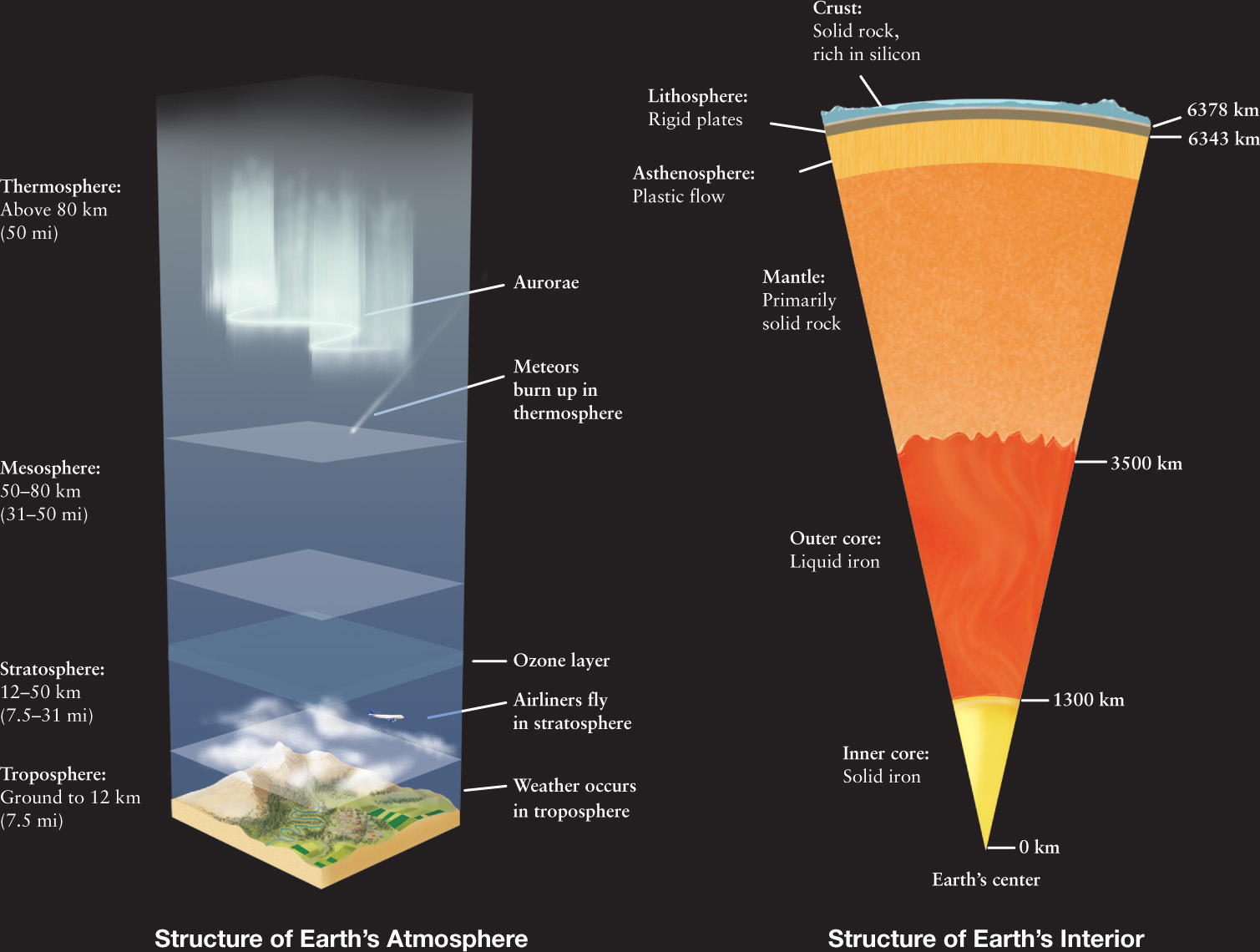9-6 Like Earth’s interior, our atmosphere has a layered structure
Circulation in our atmosphere results from convection and Earth’s rotation
While life has shaped our atmosphere’s chemical composition, the structure of the atmosphere is controlled by the influence of sunlight. Scientists describe the structure of any atmosphere in terms of two properties: temperature and atmospheric pressure, which vary with altitude.
Pressure, Temperature, and Convection in the Atmosphere
 Atmospheric pressure at any height in the atmosphere is caused by the weight of all the air above that height. For a useful analogy, if 10 students form a vertical stack—one lying on top of another—it is the bottom student who feels all the weight from those above. It is similar for air, with the greatest air pressure at Earth’s surface. The average atmospheric pressure at sea level is defined to be 1 atmosphere (1 atm), equal to 1.01 × 105 N/m2 or 14.7 pounds per square inch. As you go higher in the atmosphere, there is less air above to weigh down on you. Hence, atmospheric pressure decreases smoothly with increasing altitude.
Atmospheric pressure at any height in the atmosphere is caused by the weight of all the air above that height. For a useful analogy, if 10 students form a vertical stack—one lying on top of another—it is the bottom student who feels all the weight from those above. It is similar for air, with the greatest air pressure at Earth’s surface. The average atmospheric pressure at sea level is defined to be 1 atmosphere (1 atm), equal to 1.01 × 105 N/m2 or 14.7 pounds per square inch. As you go higher in the atmosphere, there is less air above to weigh down on you. Hence, atmospheric pressure decreases smoothly with increasing altitude.

Unlike atmospheric pressure, temperature varies with altitude in a complex way. Figure 9-24 shows that temperature decreases with increasing altitude in some layers of the atmosphere, but in other layers, it actually increases with increasing altitude. These differences result from the individual ways in which each layer is heated.
 The lowest layer, called the troposphere, extends from the surface to an average altitude of 12 km (roughly 7.5 miles, or 39,000 ft). It is heated only indirectly by the Sun. Sunlight warms Earth’s surface, which heats the lower part of the troposphere. By contrast, the upper part of the troposphere remains at cooler temperatures. This vertical temperature variation causes convection currents that move up and down through the troposphere (see Section 8-1). Much of Earth’s weather is a consequence of this convection.
The lowest layer, called the troposphere, extends from the surface to an average altitude of 12 km (roughly 7.5 miles, or 39,000 ft). It is heated only indirectly by the Sun. Sunlight warms Earth’s surface, which heats the lower part of the troposphere. By contrast, the upper part of the troposphere remains at cooler temperatures. This vertical temperature variation causes convection currents that move up and down through the troposphere (see Section 8-1). Much of Earth’s weather is a consequence of this convection.
Convection on a grand scale is caused by the temperature difference between Earth’s equator and its poles. If Earth did not rotate, heated air near the equator would rise upward and flow at high altitude toward the poles. There it would cool and sink to lower altitudes, at which it would flow back to the equator. However, Earth’s rotation breaks up this simple convection pattern into a series of convection cells. In these cells, air flows east and west as well as vertically and in a north-south direction. The structure of these cells explains why the prevailing winds blow in different directions at different latitudes (Figure 9-25).

CONCEPT CHECK 9-8
Is the atmospheric layer called the troposphere heated from above or below?
As sunlight warms Earth’s surface, energy in the form of heat increases the temperature of the troposphere near Earth’s surface such that the troposphere is heated from below.
Upper Layers of the Atmosphere
Almost all the oxygen in the troposphere is in the form of O2, a molecule made of two oxygen atoms. But in the stratosphere, which extends from about 12 to 50 km (about 7.5 to 31 mi) above the surface, an appreciable amount of oxygen is in the form of ozone, a molecule made of three oxygen atoms (O3). Unlike O2, ozone is very efficient at absorbing ultraviolet radiation from the Sun, which means that the stratosphere can directly absorb solar energy. The result is that the temperature actually increases as you move upward in the stratosphere. Convection requires that the temperature must decrease, not increase, with increasing altitude, so there are essentially no convection currents in the stratosphere.
Above the stratosphere lies the mesosphere. Very little ozone is found there, so solar ultraviolet radiation is not absorbed within the mesosphere, and atmospheric temperature again declines with increasing altitude.
 The temperature of the mesosphere reaches a minimum of about -75°C (= -103°F = 198 K) at an altitude of about 80 km (50 mi). This minimum marks the bottom of the atmosphere’s thinnest and uppermost layer, the thermosphere, in which temperature once again rises with increasing altitude. This temperature increase is not due to the presence of ozone, because in this very low-density region oxygen and nitrogen are found as individual atoms rather than in molecules. Instead, the thermosphere is heated because these isolated atoms absorb very-short-wavelength solar ultraviolet radiation (which oxygen and nitrogen molecules cannot absorb).
The temperature of the mesosphere reaches a minimum of about -75°C (= -103°F = 198 K) at an altitude of about 80 km (50 mi). This minimum marks the bottom of the atmosphere’s thinnest and uppermost layer, the thermosphere, in which temperature once again rises with increasing altitude. This temperature increase is not due to the presence of ozone, because in this very low-density region oxygen and nitrogen are found as individual atoms rather than in molecules. Instead, the thermosphere is heated because these isolated atoms absorb very-short-wavelength solar ultraviolet radiation (which oxygen and nitrogen molecules cannot absorb).
CAUTION!
At altitudes near 300 km the temperature of the thermosphere is about 1000°C (1800°F). This altitude is near the altitude at which the space shuttle and satellites orbit Earth. Nonetheless, a satellite in orbit does not risk being burned up as if in a hot oven. The reason is that the thermosphere is far less dense than the atmosphere at sea level. The high temperature simply means that an average atom in the thermosphere is moving very fast (see Box 7-2). But because the thermosphere is so thin (only about 10−11 as dense as the air at sea level), these fastmoving atoms are few and far between. Hence, the thermosphere contains very little thermal energy. When meteors burn up in the thermosphere it is because they move much faster than satellites and this generates heat regardless of the thermosphere’s average temperature.
The Cosmic Connections figure compares the layered structure of our atmosphere with that of Earth’s interior.
CONCEPT CHECK 9-9
What would happen to the temperature in the stratosphere if there were an absence of ozone?
Ozone in the stratosphere absorbs ultraviolet radiation from the Sun and helps warm the stratosphere. So, a deficit of ozone would make the stratosphere cooler in temperature.
COSMIC CONNECTIONS
Comparing Earth’s Atmosphere and Interior
Earth’s atmosphere (which is a gas) and Earth’s interior (which is partly solid, partly liquid) both decrease in density and pressure as you go farther away from Earth’s center.
